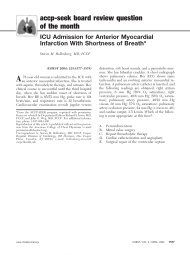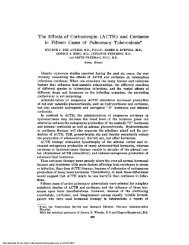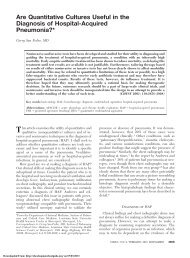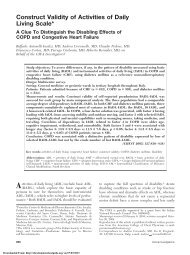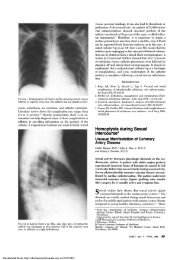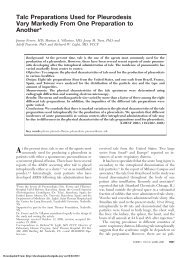Hafnia alvei*
Hafnia alvei*
Hafnia alvei*
Create successful ePaper yourself
Turn your PDF publications into a flip-book with our unique Google optimized e-Paper software.
<strong>Hafnia</strong> <strong>alvei*</strong><br />
Respiratory Tract Isolates in a Community<br />
Hospital Over a Three-Year Period and a Literature<br />
Review<br />
An Klapholz, M.D., F.C.C.P.; Klaus-Dieter Lessnau, M.D.;<br />
Benson Huang, M.D.; Wilfredo Talavera, M.D., F.C.C.P.; and<br />
John F. Boyle, Ph.D.<br />
In a retrospective review, a group of seven patients<br />
were found to have a sputum culture positive for<br />
<strong>Hafnia</strong> alvei. <strong>Hafnia</strong> alvei is a Gram-negative enteric<br />
and oropharyngeal bacillus and usually is<br />
nonpathogenic. All our patients had a chronic underlying<br />
illness and one of the patients was<br />
endotracheally intubated at the time of the isolation<br />
of this organism. Six of seven patients had other<br />
H afnia alvei is a facultative Gram-negative enteric<br />
bacillus belonging to the Enterobacteri-<br />
aceae family. It is rarely considered a pathogenic<br />
organism. Although one of the enteric flora, H alvei<br />
can be a colonizer of the oropharynx and may be a<br />
cause of pneumonia in the community or hospital<br />
setting. It has been reported as a cause of pulmo-<br />
nary infection in the literature in three patients.1’2<br />
We describe a series of patients in whom H alvei<br />
was isolated in respiratory secretions in both the<br />
community and hospital environment and review<br />
the most recent literature on this organism.<br />
MATERIALS AND METHODS<br />
We reviewed the medical records and chest radiographs of<br />
seven patients who were found to have positive cultures of H<br />
alvel in oropharyngeal or bronchial secretions. These patients<br />
had been admitted to a Midtown Manhattan teaching hospital<br />
from January 1989 to January 1992. Identification and sensitivity<br />
testing was performed in our microbiology laboratory. Isolation<br />
of the organism was performed on a trypticase soy agar plate<br />
supplemented with 5 percent CO2 for 18 to 24 h following 24 h<br />
of incubation at 35#{176}C (BBL Microbiology Systems, COC.<br />
Keysville, Md). Isolates were tested on the MicroScan Gram-<br />
negative MIC dry microdilution panel (MicroScan Division,<br />
Baxter Healthcare Corp., West Sacramento, Cal) by using the<br />
Autoscan-4 automated panel reader and computerized data<br />
management system. Sensitivity testing included 33 commonly<br />
used antibiotics. A computer-assisted review of the literature<br />
was done by Medline and additional databases.<br />
RESULTS<br />
Seven patients were identified as having sputum<br />
*From the Division of Pulmonary/Critical Care Medicine (Drs.<br />
Klapholz, Lessnau, Huang, and Talavera), and the Department<br />
of Clinical Microbiology (Dr. Boyle), Cabrini Medical Center,<br />
New York; and New York Medical College (Drs. Klapholz and<br />
Talavera), New York.<br />
Manuscript received April 23, 1993; revision accepted July 20.<br />
Reprint requests: Dr. Klapholz, Cabrini Medical Center, 227<br />
East 19th Street, New York 10003<br />
organisms isolated along with H alvei, and only one<br />
patient had a pure growth of H alvei confirmed by<br />
a culture obtained from a bronchoscopic protected<br />
brush specimen. All isolates displayed resistance to<br />
conventional antibiotics including cephalosporins<br />
and penicillins. Although rare, H alvei may be a<br />
potential pathogen in a patient with a chronic<br />
underlying illness. (Chest 1994: 105 ;1098-1100)<br />
cultures positive for H alvei as shown in Table 1.<br />
There were 5 men and 2 women with a mean age<br />
of 60 years. All the isolates were in patients with<br />
a chronic underlying illness. Isolates from patients 1<br />
to 4 were obtained within 48 h of admission and<br />
therefore presumed to be community-acquired iso-<br />
lates. The remaining patients were presumed to<br />
have nosocomial colonization. In six patients, H<br />
alvei was isolated with other pathogens, and there-<br />
fore none of the pulmonary findings could be defi-<br />
nitely attributed to H alvei alone. Clinical presenta-<br />
tion and chest x-ray film findings on admission were<br />
not helpful because of concomitant infectious and<br />
noninfectious processes. For patient 7, fiberoptic<br />
bronchoscopy was performed with a protected sheath<br />
brush which on culture revealed pure colonies of H<br />
alvei and confirmed the sputum culture of H alvei as<br />
1098 <strong>Hafnia</strong> atval in a Community Hospital (Klapholz eta!)<br />
Downloaded From: http://chestioumal.chestpubs.org/ on 07/03/2013<br />
well.<br />
Antibiotic sensitivities are summarized in Table 2.<br />
Five isolates were resistant to ampicillin. Five of<br />
seven isolates were resistant to a first-generation<br />
cephalosporin, and four of seven isolates were resis-<br />
tant to a second-generation cephalosporin. Two of<br />
seven isolates were resistant to a semisynthetic<br />
penicillin. All isolates were sensitive to the<br />
aminoglycosides, imipenem-cilastin, and the<br />
quinolones.<br />
DISCUSSION<br />
In the past, <strong>Hafnia</strong> was considered a member of<br />
the genus Enterobacter and was called Enterobacter<br />
hafnia or “paracolon” bacterium.3 With DNA and<br />
biochemical studies, it has been defined as a sepa-<br />
rate genus of the Kiebsiella family composed of<br />
bacteria motile at 25#{176} to 36#{176}Cand immotile at higher<br />
temperatures. <strong>Hafnia</strong> alvei is a small, plump bacillus
Age, yr/Ethnic Admitting Signs,<br />
Patient Group, Sex* History Symptoms, and Hospital Course Sputum Chest X-ray Film<br />
1 40/H/F Steroid-dependent<br />
Table 1-Patients With <strong>Hafnia</strong> alvei in Respiratory Secretions<br />
asthma, diabetes<br />
mellitus, intravenous<br />
drug use<br />
2 83/W/M Myelodysplastic<br />
syndrome, hyper-<br />
tension<br />
3 60/H/M Adenocarcinoma of<br />
the lung; left-sided<br />
hydropneumothorax,<br />
recent chemo-<br />
therapy<br />
4 76/W/M COPD, arterioscle-<br />
rotic heart disease,<br />
atrial fibrillation,<br />
Iupus anticoagulant<br />
5 63/W/M Chronic renal failure,<br />
idiopathic<br />
thrombocytopenic<br />
purpura<br />
6 36/W/M Human immunodefi-<br />
ciency virus positive<br />
for 1 year<br />
7 68/H/F COPD, congestive<br />
*W=white; H=Hispanic.<br />
heart failure,<br />
chronic renal<br />
failure,<br />
hypothyroidism<br />
Increasing dyspnea, expiratory<br />
wheezing; treated initially with<br />
steroids and bronchodilators<br />
Hoarseness, fever, chills, leukocytosis;<br />
laryngoscopy revealed mild glottic<br />
edema responding to cefuroxime<br />
within 3 d; steroids never adminis-<br />
tered<br />
Hemoptysis; fiberoptic bronchoscopy<br />
revealed tumor with left lower lung<br />
occlusion; remained afebrile, no<br />
antibiotics given<br />
Cough, dyspnea, minor hemoptysis;<br />
cytologic studies revealed small cell<br />
carcinoma; postobstructive<br />
pneumonia improved symptomati-<br />
cally<br />
Cardiac arrest followed by hemicolec-<br />
tomy because of colonic infarction<br />
and perforated cecum; expired with<br />
overwhelming pneumonia<br />
Productive cough, fever, pleuritic<br />
chest pain, normal leukocyte count;<br />
treated with sulfamethoxazole/<br />
trimethoprim for 14 d; discharged<br />
afebrile<br />
with a slight bipolar appearance on Gram staining.4<br />
Rectal bleeding and urinary tract<br />
infection; cardiopulmonary<br />
It is catalase- and lysine decarboxylase-positive and<br />
it does not hydrolyze arginine, thus differing from E<br />
cloacae.5<br />
<strong>Hafnia</strong> alvei has been associated with a wide array<br />
of clinical infections. It has been reported as a cause<br />
of meningitis,6 diarrhea,”7 necrotizing enterocolitis,8<br />
pneumonia 1,2 urinary tract infection , endophthal-<br />
mitis,9 and soft tissue infection.’0 In addition, Dibb”<br />
reported that H alvei was the only Gram-negative<br />
rod isolated from the outer ear canal in healthy<br />
Norwegian individuals.<br />
Washington et al’ reported the isolation of H alvei<br />
from the respiratory tract in 5 patients from a total<br />
of 760 isolates of Enterobacter over a 3-year period.<br />
Three of the patients were described as having<br />
Downloaded From: http://chestioumal.chestpubs.org/ on 07/03/2013<br />
arrest, intubation; extubation,<br />
but general condition worsened;<br />
with aztreonam on clearing<br />
radiographic infiltrates; expired<br />
#1 H alvel, Streptococ-<br />
cus pneumonia<br />
Staphylococcus aureus<br />
in blood and throat<br />
culture; 1) S aureus,<br />
Mycobacterlum<br />
gordonae, Klebsiella<br />
pneumonia, H alvel<br />
1) H alvel,<br />
Ac! netoba cter<br />
hemolyticus<br />
1) Citrobacter freundil;<br />
5) Serratia<br />
rnarcescens, M<br />
gordonae; 6) H abet,<br />
Escherichia cob!; 7)<br />
Pseudom.onas<br />
aeruginosa, S<br />
Marcescens<br />
(Bronchoalveolar<br />
lavage); 14) H alvel<br />
3) S aureus, P<br />
aeruglnosa; 14) H<br />
alvei<br />
1) A hemolyticus,<br />
Pneumocystis carinti,<br />
Asperigillus species; 2)<br />
H alvel<br />
7) H alvel; had<br />
fiberoptic<br />
bronchoscopy with<br />
protected sheath<br />
specimen brush; pure<br />
colonies of H abvei<br />
No infiltrate<br />
Minimal fibrotic<br />
changes<br />
Left lower lung<br />
infiltrate<br />
Left lower lung<br />
infiltrate<br />
Bilateral<br />
infiltrates<br />
Bilateral<br />
infiltrates,<br />
large left<br />
upper lobe<br />
bulla<br />
Cardiomegaly,<br />
left lower lung<br />
infiltrate<br />
chronic respiratory disease. Four of these isolates<br />
were from sputum samples and one was from the<br />
trachea, and all were nosocomially acquired. Three<br />
isolates were considered commensals. Two isolates<br />
(one from sputum and one tracheal isolate) were the<br />
predominant organisms in two patients with fatal<br />
bronchopneumonia, one of which also was isolated<br />
from the lung postmortem. In addition, it was<br />
shown to be an uncommon colonizer, isolated in 19<br />
of 760 isolates of Enterobacter found in stool, urine,<br />
the pharynx, oral ulcers, and wounds. As in our<br />
series, H alvei was isolated in mixed cultures and<br />
was a coisolate in 15 of those 19 isolates.<br />
In addition, Frick et a12 reported a case of H alvei<br />
pneumonia diagnosed by pure culture from a<br />
bronchoscopic specimen in a patient receiving me-<br />
CHEST/105/4/APRIL,1994 1099
Table 2-Antibiotic Sensitivities of <strong>Hafnia</strong> alvei Isolates<br />
Patient Resistance to Cephalosporine Additional Resistance Sensitivity<br />
1 None None All others, including ampicillin<br />
2 Cephalothin, cefuroxime (medium-sensitive) Ampicillin, piperacillin All others<br />
3 Cefazolin, cefuroxime, ceftazidime Ampicillin, piperacillin Ceftriaxone, aminoglycosides. cefotetan,<br />
4 Cefazolin, cefuroxime, cefotetan Aztreonam Ampicillin, piperacillin, ciprofioxacin,<br />
5 Cefazolin, cephalothin Ampicillin All others<br />
1100 <strong>Hafnia</strong> atvei in a Community Hospital (K!aplsolz eta!)<br />
aztreonam<br />
aminoglycosides<br />
6 Cephalothin, cefuroxime, ceftriaxone, Ampicillin Cefotetan, all others including<br />
ceftazidime trimethoprim/sulfamethoxazole<br />
7 None Ampicillin Aztreonam, all others<br />
chanical ventilation for 12 days. Although it is<br />
unclear from this report whether the specimen was<br />
obtained via a protected brush or bronchoalveolar<br />
lavage, the pure growth of H alvei strongly suggests<br />
that this was the offending pathogen.<br />
In our case series, H alvel was isolated from<br />
sputum at the time of admission in four of the seven<br />
cases (cases 1 to 3 and 6), suggesting that it is a<br />
community colonizer. In all of those patients, it was<br />
a coisolate with other organisms, and a clinical<br />
response was obtained without specific treatment<br />
for H alvei. Laboratory contamination was not sus-<br />
pected because there was no clustering of these<br />
isolates from a particular ward or over a specific<br />
period of time. In addition, three of the four com-<br />
munity isolates were in patients with underlying<br />
pulmonary disease. Whether this predisposed those<br />
patients to colonization as in the study of Washing-<br />
ton et a18 is not known. Of the nosocomial isolates,<br />
only patient 7 had a nosocomially acquired pneumo-<br />
nia in which H alvei was the offending pathogen.<br />
Although colony counts were not performed on the<br />
sterile brush specimen, subsequent clinical and<br />
radiographic improvement with an appropriate anti-<br />
biotic strongly implied H abel as the offending<br />
pathogen. Patient 4 had a nosocomially acquired<br />
isolate without evidence of disease. In patient 6, H<br />
alvel could have been a pathogen, but further<br />
diagnostic studies were not done.<br />
There was a pattern observed regarding the sen-<br />
sitivity of these isolates, with the majority of them<br />
resistant to ampicillin and some first- and second-<br />
generation cephalosporins (Table 2). This pattern of<br />
resistance is consistent with other case reports<br />
reviewed in the literature.”2’8”2 Six of seven patients<br />
had underlying chronic disease.<br />
Although in the majority of our cases, there was<br />
Downloaded From: http://chestioumal.chestpubs.org/ on 07/03/2013<br />
no clinical importance in isolating H alvei other<br />
than colonization, it may occasionally be the primary<br />
cause of pneumonia. In the era of rapidly<br />
evolving resistant organisms, immunosuppression<br />
and prolonged ventilator management, one must be<br />
wary of the emergence of H abel as a possible<br />
pulmonary pathogen.<br />
REFERENCES<br />
1 Washington JA, Birk RJ, Ritts RE. Bacteriologic and<br />
epidemiologic characteristics of Enterobacter hafnla and<br />
Enterobacter liquefaciens. J Infect Dis 1971; 124:379-86<br />
2 Frick T, Kunz M, Vogt M, Turina M. Typical nosocomial<br />
infection with an unusual cause: Hafnla alvel-report of 2<br />
cases and literature review. Schweiz Rund Med Praxis 1990;<br />
79:1092-94<br />
3 Fields BN, Uwayda MM, Kunz U, Swartz MN. The so-called<br />
“paracolon” bacteria. Am J Med 1967; 42:89-106<br />
4 Englund GW. Persistent septicemia due to <strong>Hafnia</strong> alvei. Am<br />
J Clin Pathol 1969; 51:717-19<br />
5 Eisenstein BI. Enterobacteriaceae. In: Mandell CL, Douglas<br />
RG, Bennet JE, eds. Principles and practice of infectious<br />
disease. 3rd ed. New York: Churchill Livingston, 1990; 1668<br />
6 Mojtabaee A, Siadati A. Enterohacter hafnla meningitis. J<br />
Pediatr 1978; 93:1062-63<br />
7 Albert MJ, Khorshed A, Moyenul I, Montanaro J, Rahman<br />
H, Haider K, at al. Hafnla alvel, a probable cause of<br />
diarrhea in humans. Infect Immunol 1991; 59:1507-12<br />
8 Ginsberg HG, Goldsmith JP. <strong>Hafnia</strong> alvei septicemia in an<br />
infant with necrotizing enterocohtis. J Perinatol 1988; 3:122-<br />
23<br />
9 Caravalho J Jr. McMillan VM, Ellis RB, Betancourt A.<br />
Endogenous ophthalznitis due to Salmonella arlzonae and<br />
Hafnla alvel. South Med J 1990; 83:325-27<br />
10 Berger S. Edberg SC, Klein RS. Enterobacter hafnla infection:<br />
report of 2 cases and review of the literature. Am J Med<br />
Sci 1977; 273:101-04<br />
11 Dibb WL. The normal microbial flora of the outer ear canal<br />
in healthy Norwegian individuals. Niph Ann 1990; 13:11-16<br />
12 Qadi HSM, Belobraydic KA. In vitro activity of aztreonam<br />
against Gram-negative bacteria from clinical specimens and<br />
its comparison with other commonly used antibiotics. Meth<br />
Find Exp Clin Pharmacol 1986; 8:223-26



